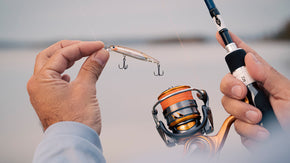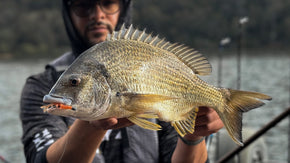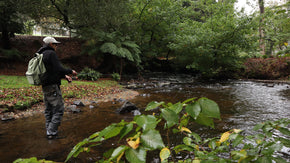Posted 24th October 2024
A Beginners Guide to Barra Tackle


By Robert Thornton
Barramundi offer a lot for anglers. Of the major drawcards, their vast distribution, huge growth potential and susceptibility to a wide range of fishing techniques stand out most. These characteristics though, while highly regarded (and rightly so), can make tackle selection for newcomers a daunting task.
Indeed, choosing weaponry for a fish that can live in both fresh and saltwater, grows to well over a metre long and changes its feeding behaviour constantly presents challenges. Learning about the lifecycle and habits of these fish will certainly help you to work out what you need to catch barra in your area, but this isn’t the purpose of this blog. To learn more about barramundi themselves, you can read my barramundi for beginners blog – the info in it is helpful to apply alongside what you’re about to read.
Instead, we’re going to break down barramundi tackle into four types of outfits, along with a few lures that work well with each one. To clarify, this isn’t to say you need four outfits to chase barra. The aim of this blog is to explain when, where and how each one is best utilised, and hopefully this will help you decide what you need to set yourself up on yourbarramundi journey in your local waterway.

HOW BIG IS BIG?
Barramundi can reach colossal sizes in the right conditions, so it goes without saying that before you even think about the finer details of your tackle, it needs to be suited to the size of the fish commonly encountered in the area. Yes, big barra can sometimes show up out of the blue in areas where the average fish is small and vice versa, but most fisheries will have a typical ‘class’ of fish on offer. Because of this, it’s important to find the best happy medium with your tackle where possible.
For example, a medium baitcaster outfit with 20lb braid is perfectly suited to snag fishing in a small tidal creek where most barra range from 50-70cm. This same setup might not hold up in a timbered lake where the average barra is over metre long, however. Similarly, the heavy and extra-heavy baitcast tackle required in such lakes may not transfer well to a tropical billabong, where lighter tackle is required to present smaller items to mostly juvenile fish.
Basically, you need to ask yourself: how big are the barra in my area? Where are they hanging out? Once you can answer these questions, tackle selection will be a lot easier.
FOUR BARRAMUNDI OUTFITS
Pretty much all barramundi fishing with lures can be covered with four main outfit types, with things like line breaking strains and lures sizes adjusted to suit the size of the fish. Let’s now go through these setups, their advantages and how they’re best utilised.
Short baitcaster
A short baitcast outfit is a very useful item in the barra arsenal and provides adequate utility across the board, but really shines in certain situations.
Casting with hardbodies such as the Steez Current Master 93 DR and EXDR is best done with a short baitcaster between 6’-6’6”, as they allow for easy downward rips of the rod to animate the jerkbaits without the rod tip hitting the water. This technique works well in estuaries and lakes.
Delivering accurate casts into heavily-structured areas is another speciality of short baitcast rods, especially with weedless rigged paddle-tail soft plastics like the Bait Junkie 4.2 and 6.2 Minnow. Additionally, the direct contact that baitcaster reels offer helps the angler to feel the lure as it bumps its way through the structure on the retrieve, as well as the tell-tale bite of a barra.
Once a barra jumps on, short and stiff rods are the perfect tool for extracting barra in tight country.
Another common use for this outfit is trolling, with barra trolling demanding lots of input from the angler. Imparting twitches and jerks as you troll is far more ergonomic with a short baitbaster, and once again this system transmits plenty of feedback to the user. Barra trolling is all about staying in touch with the lure as it vibrates through the water, knocking into structure and occasionally hitting them bottom. A skilful troller will adapt how and where they work the lure based on this feedback, and employing this style of ‘active trolling’ can be absolutely deadly on barra at times.
The Tatula 601MHFB or 661MHFB rods are good short baitcaster options for barra, and both pair well with a 200 size Tatula baitcaster reel in either 5.5:1 or 6.3:1 retrieval speeds.

Long baitcaster
A long baitcast setup is another handy tool for barra and have their own advantages. While not ideal in every scenario, long and heavy baitcasters are worth their weight in gold at times.
This setup is often employed when fishing in deep holes, or when fish are found feeding over a large area and therefore require long casts to reach. In either case, fish are usually hooked with quite a bit of line out, and taking up the slack quickly to set the hook is far easier to do with a long rod and a reel with a high gear ratio.
Presenting paddle-tail soft plastics, glidebaits and swimbaits to large impoundment fish practically demands a long, heavy baitcast setup. This type of outfit is perfect for delivering repeated long casts with heavy lures and keeping tension when barra jump and shake their heads with lots of line out. Long rods are also handy for leading and steering big barra during their powerful runs by utilising rod angles; a technique that flyfishers often employ on the flats to tire out dogged fighters like GTs and permit.
Swimbait specific rods are ideal for these techniques, with a TD Black baitcast rod in either the Lil’ Mumma or Mother models (7’6” and 7’9” respectively) providing a heavy and extra-heavy option. High-speed baitcaster reels with large internal gears and plenty of drag pressure are a perfect match for these rods, with the Lexa TW 300H-P and Tatula 300HS both suitable accompaniments.
Short spin
Spin rods have always been popular for barra for a variety of reasons, not least because of how easy they are to use compared to baitcasters. There’s certainly nothing wrong with using a short spin rod in tight country, however, baitcasters usually offer more advantages.
There are exceptions though, and flicking lightly-weighted plastics rigged weedless into heavy cover is one technique that is far easier to do with a short spin rod. Soft plastic prawn and frog imitations rigged with little or no weight can be difficult to cast on baitcasters, let alone accurately, but a short and tippy spin stick between 6’-6’6” will do the job with ease. With a good setup you can skip these lures under overhangs, through tight gaps and into the unknown. Down on the butt end, a decent spin reel spooled with braid helps to quickly take up the slack to set the hook in tight confines.
Skip casting with a Bait Junkie Kikker Curly and 5” Prawn along mangrove and snag-lined banks is what the Mangrove Masher and Swamp Donkey models of TD Black spin rods (both 6’4”) were developed for. Any decent spin reel in a 4000-8000 size will be fine, with strong bodied series like the Maverick MQ a good choice, though you can get by with reels in lower price brackets.

Long spin
Our final barra outfit is a long spin rod, somewhere between 7-8’. Once again, these outfits have uses across the board, but are at their best when used for specific jobs. Like long baitcasters, open areas and deep holes are where long spin rods prove their worth and tend to fill in the gaps that baitcasters leave.
Frog fishing in impoundments, billabongs or open flat areas are prime scenarios for a long spin stick, as they allow long casts with light lures. Spin reels are perfect for maintaining a quick and constant retrieve that frog feeding barra love, and once a fish implodes the frog, the long rod comes back into play to make setting the hook possible with lots of line out.
Another common use for long spin rods is fishing in deep holes, in particular when slowly working soft vibes like the Steez Soft Shell 90 and other plastics. Fishing these lures in deep water with lots of pauses and movements of the rod heightens the potential for slack in the system. With a long spin rod and reel combo you can quickly take up the slack if a bite is detected and set the hook.
The 7’6” Garuda from the Commander spin rod range is a great long spin rod option for barra, however a TD Black Macka at 7’4” is another perfectly suitable option and one that’s more affordable. Once again, a 4000-8000 size spin reel completes this set up.
Build your armoury
While it’s not necessary to have all of these outfits with you to catch barra, between these four an angler can cover just about any barra situation they may be confronted with, whether in fresh or saltwater, in the deep or way up shallow.
If you’re looking to build a collection of barra tackle, think about the sort of environment you’ll be fishing and the class of barra you’re likely to tangle with. This is the key to selecting the right tackle. It may take a little trial and error, but once you get your preparation right, the barra will come.
















